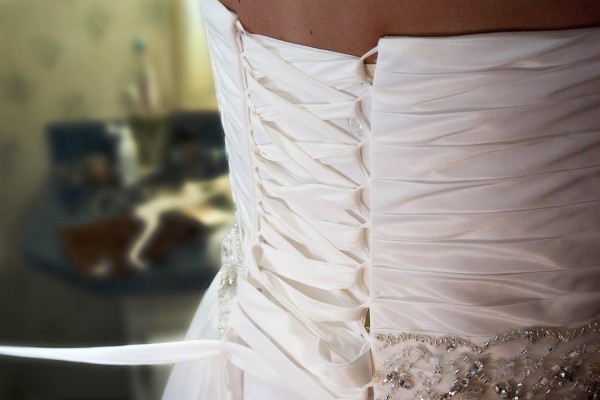You’ve waited your whole life for the big day, and it’s getting closer.
After your flowing white gown has served its purpose of presenting you in all the symbolism of the best day of your life, after all the pictures have been taken, and after all the tears of joy have been shed, your gown will serve you as a reminder of your wedding day. Taking good care of your gown can help it stay as beautiful as it was on your magical day.
If your dress is properly stored, it can even be available to another blushing bride someday, perhaps your daughter or granddaughter. (Here’s how to store your gown before the wedding day).
Understanding Wedding Gown Fabrics and The Cleaning Care Required
Wedding gowns are generally composed of many sensitive fabrics and trims. Some are satin, shantung, organdy, taffeta, lace, sequins, beads, rhinestones, and any combination of those fabrics with trims. Problems can develop with any or all of these fabrics and trims if they are left in the sun, or if invisible gasses make contact with them during storage, or the dress is left in a hot attic or a damp basement.
The whiteness of the gown is a fragile mix of fibers, colorings, and whiteners. Proper storage can minimize the yellowing of certain fabrics and protect the fabric from light.
Beware of invisible stains from food, beverages, and body oil. If these stains are not properly cleaned, they may become permanent. Cleaning industry experts recommend that you have the dress cleaned by a professional before storing it.
Most wedding gowns have some sort of decorative trim. Be sure to inspect these trims with your cleaner prior to cleaning since many trims are not made to withstand the dry cleaning process. For example, many beads, glitter, sequins, and laces are attached to gowns with adhesives that dissolve during dry cleaning. Some beads and glitter are made of plastics or are covered with surface coatings that are not drycleaning-resistant. In many of these cases the trim becomes separated from the dress or is altered in some way. It’s extremely important your cleaner understands the above to avoid long term damage.
Wedding Gown Storage
Wedding gowns are normally cleaned only once and then stored. That is why proper storage is so important to prevent damage and help maintain the original appearance of the gown. While in storage you want to slow down the aging process of the gown by using good quality storage materials, thus increasing your chances of preserving the gown for posterity or even later use.
Methods of Storage
Be sure to have the gown cleaned as soon as possible after wearing to prevent the setting of stains from body oils, makeup or spills. Preserving or packaging your gown can be done in a number of ways.
Hanger and Bag
The gown is cleaned and finished in the same manner as a regular drycleaning item. If you are storing your gown on a hanger, sew straps to the waistline of the dress to relieve pressure on the shoulders from the weight of the skirt. Wrap the dress in a protective white sheet or muslin covering.
Box and Tissue Paper
After the gown is cleaned and finished, it is packed in a box with white acidfree unbuffered tissue paper to prevent hard wrinkling.
Any folds should be carefully padded with acid-free unbuffered tisue paper or clean washed cotton fabric so there are no sharp creases. In storing the gown, it is also reccomended that the foam padding (i.e., shoulder pads), metal buttons or other metallic trim be stored separately. These materials may oxidize or deteriorate, permanently staining the gown.
Storage Tips
Store your gown in a cool, dry place, such as under your bed. Doing this will slow the aging process of the fabric. Do not store it in a basement or attic. Basement dampness could cause mildew, while attic heat could lead to fabric yellowing.
Whether the gown is hung or boxed, the bodice should be stuffed with white tissue paper to prevent wrinkles. Fabric-covered buttons, pins, sponge padding, and perspiration shields should be removed and stored separately to avoid damage to the fabric.
Never store headpieces, veils, shoes or other accessories with your gown.
Inspect your gown from time to time during storage. Stains not apparent initially could appear later and should be attended to immediately. Polyurethane bags, such as those wrapped around garments when picked up at the cleaners, are not suitable for long-term use. These bags are intended to shield your garments from weather, spills or other unforeseeable accidents as you take them home, and that is all. They are usually made with lots of plasticizers and lubricants, additives that can result in fabric damage during long- term storage.
If you are storing your gown in a plastic box or bag, the garment should be thoroughly dry and the humidity low when the plastic is sealed around the gown or box. Moisture inside the package can cause mildew if there are subsequent temperature changes, which can result in condensation of any moisture trapped inside.
In an ever-changing world, a wedding gown captures the hopes and dreams of family and stability. The value to the owner of such a cherished possession cannot be overestimated. Effective long-term care for such garments can be a remarkable cost-effective investment for a proud owner.
Classic Cleaners will consult extensively with you (here’s how) prior to cleaning the gown to set expectations and if you choose to preserve the gown, our preservation comes with a 100% Guarantee that the gown will not yellow in storage. We are the only dry cleaning company in the Indianapolis area endorsed by the Association of Wedding Gown Specialists.
Contact us today at 317-845-5244 to schedule a consultation.
– S.O.



